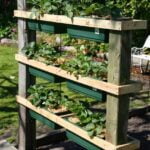Are you looking to transform your outdoor space? Whether it’s a small garden or a large backyard, landscape ideas before and after can make a significant difference in the overall look and feel of your property. The concept of before and after landscape ideas involves assessing the current state of your outdoor space, identifying areas for improvement, and implementing design changes to create a stunning transformation.
The importance of transforming outdoor spaces goes beyond aesthetics. A well-designed landscape can enhance the curb appeal of your home, create functional living spaces, and increase the value of your property. By using before and after landscape ideas as inspiration, you can turn an ordinary outdoor area into a beautiful and inviting space that you can enjoy for years to come.
In this article, we will explore the concept of before and after landscape ideas, providing inspiration for transforming different types of landscapes. We will discuss budgeting and planning tips, various design ideas using different plants and materials, as well as the pros and cons of DIY projects vs. hiring professional landscapers.
Additionally, we will provide a step-by-step guide on how to implement these ideas and maintain your new landscape. So whether you’re looking to make small changes or undertake a complete makeover, this article has everything you need to get started on transforming your outdoor space.
Assessing the Before
Before embarking on any landscape transformation project, it’s important to take stock of the current state of your outdoor space. Assessing the “before” allows you to identify any issues or areas for improvement, and sets the stage for a successful landscape makeover.
Start by taking a walk around your yard and making note of any problem areas. This could include things like overgrown or dead plants, uneven terrain, poor drainage, or lack of functionality in certain areas. It’s also important to consider the overall aesthetic and whether it aligns with your personal style and vision for your outdoor space.
In addition to visual assessments, consider practical factors such as how you currently use your outdoor space and what changes would make it more functional for your needs. For example, if you enjoy entertaining, you may want to create designated seating areas or add features like an outdoor kitchen or fire pit.
Taking the time to thoroughly assess the “before” of your landscape will provide valuable insights that will inform the design and planning stages of your transformation project. Whether you choose to tackle it yourself or hire a professional landscaper, understanding the current state of your landscape is a crucial first step towards creating a beautiful and functional outdoor oasis.
| Issues | Areas for Improvement |
|---|---|
| Overgrown plants | Create designated seating areas |
| Uneven terrain | Add features like an outdoor kitchen or fire pit |
| Poor drainage | Enhance overall aesthetic based on personal style and vision |
Inspiration
Landscape transformations can be a daunting task, but they also offer an exciting opportunity to completely revamp outdoor spaces. Looking at before and after transformations of different landscapes can provide valuable inspiration and ideas for your own project. Whether it’s updating a small backyard or completely redesigning a large garden, seeing the dramatic changes that are possible can motivate homeowners to take action.
One of the most common reasons for tackling a landscape transformation is to address existing issues or areas for improvement. For example, an overgrown and unkempt yard may be transformed into a beautifully landscaped oasis with the right design ideas and implementation. By assessing the “before” state of your landscape, you can identify specific problems that need to be addressed and develop a vision for what it could look like once transformed.
Several elements come into play when considering landscape ideas before and after. These include budgeting, materials, plants, features, and potential costs. Some projects may require significant planning and financial investment, while others can be achieved with a modest budget. Regardless of the scale of the project, having a clear plan in place is essential for a successful before and after transformation.
| Before Transformation | After Transformation |
|---|---|
| Overgrown grass and weeds | Lush green lawn with carefully manicured landscaping |
| Cracked pavement and outdated patio | New hardscaping featuring modern materials and design |
| Lack of foliage or visual interest | Diverse plantings creating visual appeal throughout the property |
Budgeting and Planning
When considering a landscape transformation, budgeting and planning are crucial steps to ensure the project’s success. It is essential to assess the current state of your outdoor space and identify areas for improvement before diving into the planning process. By creating a solid budget and timeline, you can avoid potential setbacks and ensure that your landscape ideas before and after come to life as envisioned.
Here are some tips for budgeting and designing a landscape transformation:
1. Assess the Before: Start by evaluating your current landscape and identifying any issues or areas that need improvement. This could include overgrown plants, outdated hardscaping, or poor drainage. By understanding the existing state of your outdoor space, you can better plan for the necessary changes.
2. Set a Realistic Budget: Determine how much you are willing to invest in your landscape transformation. Consider factors such as materials, labor costs if you choose to hire professionals, and any additional features or amenities you want to incorporate into your new design.
3. Research Potential Costs: Research the potential costs of different elements of your landscape transformation, such as new plants, hardscaping materials, irrigation systems, or lighting fixtures. This will give you a better understanding of where your budget should be allocated.
4. Create a Timeline: Establish a realistic timeline for your project based on the scope of work and potential challenges that may arise. Depending on the size of your outdoor space and the extent of the transformation, it’s important to set achievable deadlines for each phase of the project.
By carefully considering these budgeting and planning tips, you can set yourself up for success when bringing your landscape ideas before and after to fruition. With a clear vision, realistic budget, and well-thought-out timeline in place, you can confidently move forward with transforming your outdoor space into a beautiful and functional oasis.
Design Ideas
When it comes to transforming outdoor spaces, the design ideas are a crucial element in achieving stunning before and after landscape transformations. Whether you are looking to create a serene and peaceful garden retreat or a vibrant and colorful backyard oasis, there are endless design possibilities to explore. Here are some design ideas to consider when planning your landscape transformation:
1. Plant Selection: One of the most important aspects of landscape design is the selection of plants. Consider incorporating a mix of native plants, colorful flowers, and evergreen shrubs to add depth and texture to your outdoor space. Furthermore, think about the seasonal changes and choose plants that will bloom at different times of the year for year-round beauty.
2. Hardscaping Features: Introducing hardscaping elements such as pathways, patios, and retaining walls can add structure and functionality to your landscape. Materials like natural stone, pavers, and gravel can be used to create visually appealing pathways and seating areas. Additionally, water features like fountains or ponds can bring a sense of tranquility to the space.
3. Outdoor Living Spaces: Consider creating dedicated outdoor living areas for entertaining or relaxation. This can include adding features such as pergolas, fire pits, or outdoor kitchens. These elements not only enhance the usability of your outdoor space but also add an inviting atmosphere for gatherings with family and friends.
By carefully considering these design ideas, you can successfully plan a landscape makeover that will drastically improve the look and functionality of your outdoor area. Remember that every element you incorporate should complement each other to create a cohesive and aesthetically pleasing environment. With thoughtful planning and creativity, you can achieve a remarkable before-and-after transformation that will elevate your outdoor living experience.
DIY vs Hiring a Professional
When it comes to transforming a landscape, one of the first decisions to make is whether to tackle the project as a do-it-yourself (DIY) endeavor or hire a professional landscaper. Both options have their own set of pros and cons, and it’s important for homeowners to carefully consider which route would be best for their specific needs and goals.
Pros and Cons of DIY Landscape Projects
Taking on a landscaping project as a DIY endeavor can be an enjoyable and fulfilling experience for many homeowners. It allows for complete creative control over the design and implementation, as well as the opportunity to save money on labor costs.
DIY projects also give homeowners the chance to learn new skills and gain a sense of pride in completing the transformation themselves. However, DIY landscaping requires a significant time commitment, physical labor, and may involve a learning curve for those who are new to outdoor projects.
Pros and Cons of Hiring a Professional Landscaper
On the other hand, hiring a professional landscaper can offer numerous benefits, including expertise in design, access to specialized equipment, and a quicker timeline for completion. Professional landscapers also bring experience and knowledge that can result in high-quality results and may offer ongoing maintenance services. However, this option typically comes with higher costs due to labor and materials, as well as limited control over the design process for homeowners who prefer hands-on involvement.
Ultimately, whether to pursue DIY landscape projects or hire a professional landscaper depends on each homeowner’s individual preferences, budget constraints, timelines, and desired level of involvement in the transformation process. Regardless of the chosen path, it’s crucial to carefully weigh the pros and cons before making a decision in order to achieve successful before-and-after landscape ideas that meet one’s expectations.
Implementation
When it comes to implementing landscape ideas before and after, it’s crucial to have a clear step-by-step plan in place. Whether you’re making small changes or undergoing a complete transformation, careful execution is essential for achieving the desired results. This section will provide a comprehensive guide on how to implement and execute landscape ideas before and after, along with valuable tips for maintaining the new landscape.
Step 1: Clearing and Preparing the Area
Before you can begin implementing your landscape ideas, it’s important to clear the area of any debris, unwanted plants, or structures. This may involve removing old shrubs, trees, or garden features that no longer fit with your vision for the space. Once the area is cleared, take the time to assess the soil quality and make any necessary improvements. Properly preparing the ground will set the stage for healthy plant growth and overall success of your landscape transformation.
Step 2: Installation of Hardscaping Elements
If your landscape design includes hardscaping elements such as patios, walkways, or retaining walls, this is the time to proceed with their installation. Carefully follow any design plans or layouts to ensure that these features are built according to specifications. Consider using durable materials that complement the overall aesthetic of your outdoor space while providing functionality and durability.
Step 3: Planting and Softscape Installation
When it comes to planting new trees, shrubs, and flowers as part of your landscape transformation, thoughtful planning is key. Consider factors such as sunlight exposure, water requirements, and mature size when selecting plant varieties for different areas of your yard. Be mindful of spacing and placement to avoid overcrowding as plants grow over time. As you install softscape elements, pay attention to proper watering techniques and ongoing maintenance to ensure their long-term health.
By following this step-by-step guide on implementing landscape ideas before and after, you can bring your outdoor vision to life while creating a stunning environment that enhances your property’s beauty and functionality. With careful planning and execution, you’ll be able to enjoy a transformed landscape that reflects your personal style and meets your practical needs for years to come.
Final Thoughts
In conclusion, the concept of before and after landscape ideas is not just about transforming outdoor spaces; it’s about creating a new environment that enhances the beauty of a property while also improving its functionality. By assessing the current state of the landscape and identifying areas for improvement, homeowners can take inspiration from before and after transformations to create their own unique outdoor oasis.
Budgeting and planning are essential steps in any landscape transformation project. Understanding potential costs and timelines can help homeowners make informed decisions about their design ideas, whether it’s incorporating different plants, materials, or features. While some may choose to tackle the project themselves, hiring a professional landscaper can save time and ensure a successful outcome.
Ultimately, implementing and executing landscape ideas before and after requires careful consideration and maintenance. Taking action to transform outdoor spaces not only adds value to a property but also enhances the overall quality of life for those who enjoy it. Whether it’s a small DIY project or a complete overhaul with professional help, the benefits of landscape transformations are undeniable, leading to an improved aesthetic appeal and increased enjoyment of outdoor living spaces.
Frequently Asked Questions
What Are the 7 Steps to Landscape Design?
The 7 steps to landscape design include: 1) Set goals and budget, 2) Make a rough sketch of the area, 3) Consider the elements you want in your design, such as plants, trees, and hardscaping, 4) Choose the right plants and materials for your climate and soil type, 5) Create focal points and balance in your design, 6) Install and maintain the landscape over time, and 7) Regularly assess and make changes as needed.
What Are Five Tips to a Good Landscape?
Five tips to a good landscape include: 1) Design for all seasons by incorporating plants that bloom or change color throughout the year, 2) Use native plants that are adapted to the local climate and require less maintenance, 3) Create focal points within your landscape to draw attention to key areas, such as a beautiful tree or sculpture, 4) Consider the balance of softscaping (plants) with hardscaping (patios, walkways), and 5) Incorporate sustainable practices like water conservation and using environmentally-friendly materials.
How Do You Transform a Boring Backyard?
To transform a boring backyard, consider adding elements such as a patio or deck for entertaining, planting new trees or shrubs for added greenery, creating designated spaces for gardening or relaxation, installing outdoor lighting for ambiance in the evenings, adding water features like a fountain or pond for visual interest, and incorporating decorative elements like outdoor art or sculptures.
By combining these different features creatively, you can turn a dull backyard into a more inviting and enjoyable space.

Welcome to my gardening blog! I am passionate about plants and enjoy sharing my knowledge and experiences with others. In this blog, I will write about everything related to gardening, from tips on how to get started to updates on my own garden projects.





